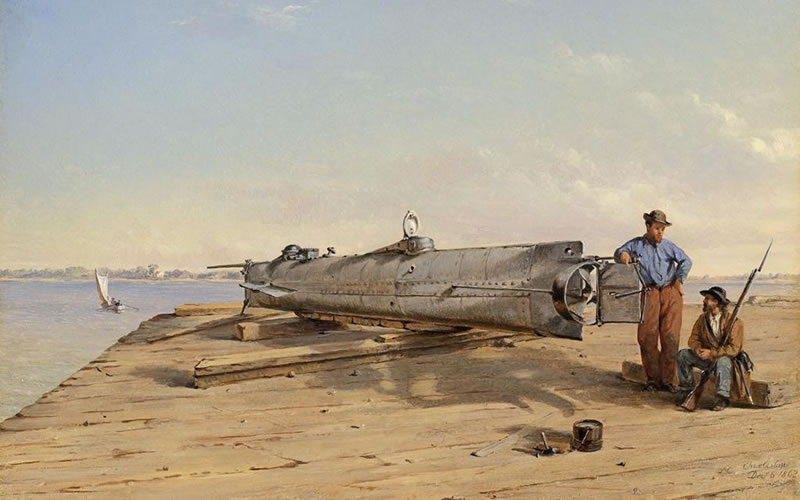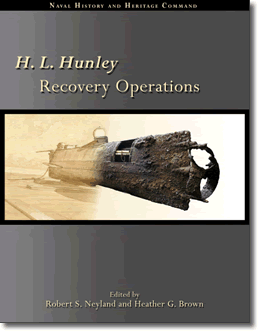
An 1863 painting of the H.L. Hunley by Conrad Wise Chapman. Source.
Staff reports | The U.S. Navy last week released a 321-page archaeological report on the recovery of the Civil War submarine H.L. Hunley two days before the 153rd anniversary of the loss of the boat.
“H. L. Hunley Recovery Operations, A Collaborative Project of: Naval History and Heritage Command, South Carolina Hunley Commission and Friends of the Hunley,” by Robert S. Neyland, Ph.D., principal investigator and Heather Brown is a comprehensive report that covers the recovery of Hunley, from the planning stages through execution. The book can be downloaded for free through the link above on the Naval History and Heritage Command (NHHC) website.
 According to a news release, the Feb. 15 report also provides detailed descriptions of objects excavated from the seabed and provides in-depth analysis of the submersible’s hull condition at the time of recovery. Further reports documenting the excavation of the interior, including crew remains, personal effects and hull components will be forthcoming.
According to a news release, the Feb. 15 report also provides detailed descriptions of objects excavated from the seabed and provides in-depth analysis of the submersible’s hull condition at the time of recovery. Further reports documenting the excavation of the interior, including crew remains, personal effects and hull components will be forthcoming.
Also last week, the NHHC released a web-article detailing the collaborative efforts of archaeologists at the Warren Lasch Conservation Center at Clemson University; ship engineers at Naval Surface Warfare Center Carderock Division; underwater explosive specialists at Naval Surface Warfare Center Indian Head EOD Technology Division; and a research team from the Marine Structures Design Laboratory at the University of Michigan. Using advanced digital modeling and simulation techniques, the team studied the effects of the explosion on Hunley and its crews, and the hull’s seagoing characteristics, to help understand the mystery of what caused Hunley to sink immediately after it carried out an attack on USS Housatonic off Charleston harbor on Feb. 17, 1864.
On Feb. 17, 1864, after months of practice runs and weather delays, the Confederate submarine Hunley, under cover of darkness, silently approached USS Housatonic, a 16-gun, 1,240-ton sloop-of-war, on blockade duty four miles off the entrance to Charleston Harbor. Carrying a torpedo packed with explosive black powder bolted to a 16-foot spar, Hunley rammed Housatonic below the water line, detonating the torpedo, tearing a hole in the Union ship’s hull and sending her to the bottom along with five of her crew. The Hunley was not seen again for more than a century.
The wreck of the boat was discovered 131 years later by a team of scientists sponsored by best-selling author Clive Cussler, after a 14-year search. Research on the site continued until the summer of 2000 when a large team of professionals from the Naval History and Heritage Command’s Underwater Archaeology Branch, the National Park Service, the South Carolina Institute of Archaeology and Anthropology excavated the site, measuring and documenting the hull prior to preparing it for removal. Once the on-site investigation was complete, customized slings were slipped underneath the sub one by one and attached to a truss designed by Oceaneering, International, Inc. The truss was then hoisted from the murky waters by crane from the jack-up barge Karlissa-B. On August 8 at 8:37 a.m., the sub broke the surface for the first time in more than 136 years.
Hunley was installed at the Warren Lasch Conservation Center, now part of the Clemson University Restoration Institute, in a specially designed tank of fresh water. Conservation efforts continue today, with support from Clemson University and the Friends of the Hunley. ·
- To learn more about the Confederate submersible H. L. Hunley, visit the NHHC website here.
- Have a comment? Send to: editor@charlestoncurrents.com



 We Can Do Better, South Carolina!
We Can Do Better, South Carolina!

























2 Comments